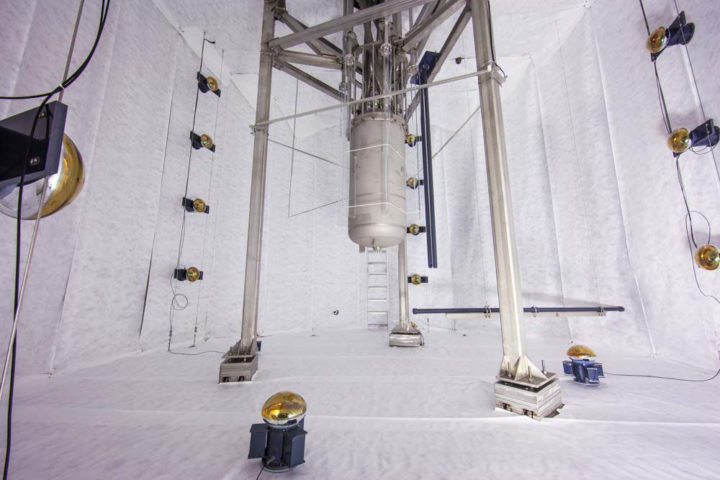New Results from LUX: World’s Most Sensitive Dark Matter Detector Gets Better
The Large Underground Xenon (LUX) dark matter experiment, operating nearly a mile underground at the Sanford Underground Research Facility (SURF) in the Black Hills of South Dakota and involving roughly 100 international scientists — including Texas A&M University physicist Robert C. Webb — has already proven itself to be the most sensitive detector in the hunt for dark matter, the mysterious and unseen force believed to account for nearly three-fourths of the matter in the universe.
Now, a new set of calibration techniques employed by LUX scientists has again dramatically improved the experiment’s sensitivity more than 20 times, says Webb — findings that are described in a paper submitted to Physical Review Letters and posted to ArXiv.
Researchers with LUX are looking for WIMPs, weakly interacting massive particles, which are among the leading candidates for dark matter. Their latest published work re-examines data collected during LUX’s first three-month run in 2013 and helps to rule out the possibility of dark matter detections at low-mass ranges where other experiments had previously reported potential detections.


“It is vital that we continue to push the capabilities of our detector in the search for the elusive dark matter particles,” said Rick Gaitskell, professor of physics at Brown University and co-spokesperson for the LUX experiment. “We have improved the sensitivity of LUX by more than a factor of 20 for low-mass dark matter particles, significantly enhancing our ability to look for WIMPs.”
Webb, holder of the Ed Rachal Chair in High-Energy Physics in the Texas A&M Department of Physics and Astronomy, is a co-principal investigator on the LUX project, which is managed by U.S. Department of Energy’s Lawrence Berkeley National Laboratory and supported by both the DOE and National Science Foundation. The worldwide scientific collaboration includes 19 research universities and national laboratories in the United States, the United Kingdom and Portugal. Webb and the late Texas A&M physicist James White were two of its founding members.
Dark matter is thought to be the dominant form of matter in the universe. Scientists are confident in its existence because the effects of its gravity can be seen in the rotation of galaxies and in the way light bends as it travels through the universe. Because WIMPs are thought to interact with other matter only on very rare occasions, they have yet to be detected directly.
LUX consists of a third-of-a-ton of liquid xenon surrounded with sensitive light detectors. It is designed to identify the very rare occasions when a dark matter particle collides with a xenon atom inside the detector. When a collision happens, the xenon atom will recoil and emit a tiny flash of light, which is detected by LUX’s light sensors. The detector’s location at Sanford Lab beneath a mile of rock helps to shield it from cosmic rays and other radiation that would interfere with a dark matter signal.
Although LUX hasn’t yet detected a dark matter signal, its exquisite sensitivity has allowed scientists to all but rule out vast mass ranges where dark matter particles might exist. These new calibrations increase that sensitivity even further.
“This latest result comes from a refined analysis of our previous data in association with a number of new detector calibrations that have allowed us to probe for low-mass dark matter particles with a sensitivity more than 20 times that of our earlier result,” Webb said. “Our team, one of the founding members of the LUX experiment, is currently involved in a longer data-taking run with this detector, which we expect will further improve our sensitivity to higher-mass dark matter particles when that measurement concludes in mid-2016.”
Webb notes that planning for a next-generation dark matter experiment at Sanford Lab is already under way. In late 2016 LUX will be decommissioned to make way for a new, much larger xenon detector, known as the LUX-ZEPLIN (LZ) dark matter experiment. Compared to LUX’s third-of-a-ton of liquid xenon, LZ will feature a 10-ton liquid xenon target that will fit inside the same 72,000-gallon tank of pure water used by LUX.
“This new experiment will have a total mass of 10 tons of liquid xenon and a sensitivity of around 100 times that of the current LUX experiment,” Webb said. “This new detector will push the frontier for direct dark matter detection into a region of sensitivity unexplored by current experiments.”
To read more about the LUX experiment, from current results and next steps to background and a complete list of collaborators, please see the official press release or go to LUX Research Facility.
For more on Webb and his research, visit Dr.Robert Webb.
To learn more about dark matter and the LUX experiment, check out Science Friday’s related spotlight featuring the following short documentary, 4850 Feet Below: The Hunt for Dark Matter, which recently won a 2015 Raw Science TV Film Festival Award for Professional Documentary Works:
# # # # # # # # # #
About Research at Texas A&M University: As one of the world’s leading research institutions, Texas A&M is at the forefront in making significant contributions to scholarship and discovery, including that of science and technology. Research conducted at Texas A&M represented annual expenditures of more than $854 million in fiscal year 2014, ranking Texas A&M in the top 20 of the National Science Foundation’s Higher Education Research and Development survey (2014). Texas A&M’s research creates new knowledge that provides basic, fundamental and applied contributions resulting in many cases in economic benefits to the state, nation and world. To learn more, visit http://research.tamu.edu.
-aTm-
Contact: Shana K. Hutchins, (979) 862-1237 or shutchins@science.tamu.edu or Dr. Robert C. Webb, (979) 845-4012 or webb@physics.tamu.edu
